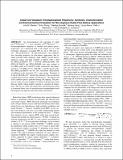Cobalt and Vanadium Trimetaphosphate Polyanions: Synthesis, Characterization, and Electrochemical Evaluation for Non-aqueous Redox-Flow Battery Applications
Author(s)
Gvozdik, Nataliya; Stevenson, Keith J.; Stauber, Julia M.; Zhang, Shiyu; Jiang, Yanfeng; Avena, Laura; Cummins, Christopher C; ... Show more Show less
Downloadcobalt_and_vanadium.pdf (1.064Mb)
PUBLISHER_POLICY
Publisher Policy
Article is made available in accordance with the publisher's policy and may be subject to US copyright law. Please refer to the publisher's site for terms of use.
Terms of use
Metadata
Show full item recordAbstract
An electrochemical cell consisting of cobalt ([Co[superscript II/III](P₃O₉)₂]4⁻/3⁻) and vanadium ([V[superscript III/II](P₃O₉)₂]3⁻/4⁻) bistrimetaphosphate complexes as catholyte and anolyte species, respectively, was constructed with a cell voltage of 2.4 V and Coulombic efficiencies >90% for up to 100 total cycles. The [Co(P₃O₉)₂]4⁻ (1) and [V(P₃O₉)₂]3⁻ (2) complexes have favorable properties for flow-battery applications, including reversible redox chemistry, high stability toward electrochemical cycling, and high solubility in MeCN (1.09 ± 0.02 M, [PPN]₄[1]·2MeCN; 0.77 ± 0.06 M, [PPN]3[2]·DME). The [PPN]₄[1]·2MeCN and [PPN]₃[2]·DME salts were isolated as crystalline solids in 82 and 68% yields, respectively, and characterized by 31P NMR, UV/vis, ESI-MS(−), and IR spectroscopy. The [PPN]₄[1]·2MeCN salt was also structurally characterized, crystallizing in the monoclinic P21/c space group. Treatment of 1 with [(p-BrC₆H₄)₃N]⁺ allowed for isolation of the one-electron-oxidized spin-crossover (SCO) complex, [Co(P3O₉)₂]₃– (3), which is the active catholyte species generated during cell charging. The success of the 1-2 cell provides a promising entry point to a potential future class of transition-metal metaphosphate-based all-inorganic non-aqueous redox-flow battery electrolytes.
Date issued
2018-01Department
Massachusetts Institute of Technology. Department of ChemistryJournal
Journal of the American Chemical Society
Publisher
American Chemical Society (ACS)
Citation
Stauber, Julia M. et al. “Cobalt and Vanadium Trimetaphosphate Polyanions: Synthesis, Characterization, and Electrochemical Evaluation for Non-Aqueous Redox-Flow Battery Applications.” Journal of the American Chemical Society 140, 2 (January 2018): 538–541 © 2017 American Chemical Society
Version: Author's final manuscript
ISSN
0002-7863
1520-5126